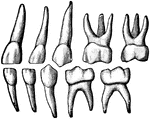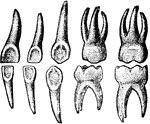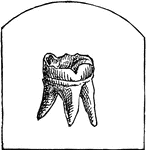This human anatomy ClipArt gallery offers 82 illustrations of human teeth and jaws. This includes external and internal views focusing on human adult and juvenile teeth. Views of teeth within the jaw bones are also included.

Permanent Teeth
The permanent teeth of the right side. The numbers show at what age they appear. Labels: a, incisors;…

Permanent Teeth
The permanent teeth of the right side, outer or labial aspect. The upper row shows the upper teeth,…

Permanent Teeth
The permanent teeth of the right side, inner of lingual aspect. The upper row shows the upper teeth,…
!["A Tooth is one of the hard bodies of the mouth, attached to the skeleton, but not forming part of it and developed from the dermis or true skin. True teeth consist of one, two, or more tissues differing in their chemical composition and in their microscopical appearances. Dentine, which forms the body of the tooth, and 'cement,' which forms its outer crust, are always present, the third tissue, the 'enamel,' when present, being situated between the dentine and cement. The incisors, or cutting teeth, are situated in front. In men there are two of these incisors in each side of each jaw. The permanent incisors, molars, and premolars are preceded by a set of deciduous or milk teeth, which are lost before maturity, and replaced by the permanent ones. The canines come next to the incisors. In man there is one canine tooth in each half-jaw. The premolars (known also as bicuspids and false molars) come next in order to the canines. In man there are two premolars in each half-jaw. The true molars (or multicuspids) are placed most posteriorly. In man there are three molars in each half-jaw, the posterior one being termed the wisdom tooth. The figures [in the illustration] refer to years after birth."—(Charles Leonard-Stuart, 1911)](https://etc.usf.edu/clipart/15200/15257/teeth2_15257_mth.gif)
Second Teeth
"A Tooth is one of the hard bodies of the mouth, attached to the skeleton, but not forming part of it…

Structure of the Teeth
Structure of the teeth. A tooth consists of 3 structures, the dentine (2), or ivory, the proper dental…

Temporary Teeth
The temporary (baby) teeth. On the left are the teeth of the left side of the mouth viewed from the…
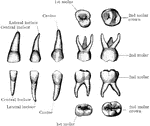
Temporary Teeth
The temporary teeth of the left side. The masticating surfaces of the tow upper molars are shown above.…
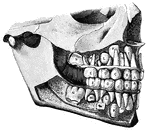
Temporary and permanent teeth
"Temporary Teeth: A, central incisors; B, lateral incisors; C, canines;…

The Teeth
Characteristics of the teeth. Teach tooth consists of a crown or body, projecting above the gum; root…
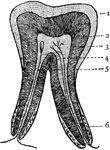
Tooth
Vertical section of a tooth. 1: Enamel; 2: Dentine; 3: Pulp; 4: Blood-vessel; 5: Nerve; 6: Fibrous cement.
Development of a Tooth
Diagram to illustrate the development of a tooth. I. Shows the downgrowth of the dental lamina D.L.…
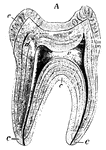
Human Tooth
A tooth is generally described as possessing a crown, neck, and root. Side view of a tooth.
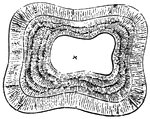
Human Tooth
A tooth is generally described as possessing a crown, neck, and root. Top view of a tooth.; 1. Central…

Human Tooth
A sectional view of a human molar. The roots, or fangs, are shown covered by a layer of bone called…

The Structure of a Tooth
The internal view of a tooth cut through from the top or crown to the tips of the root. Labels: 1, enamel;…

Vertical Section of a Tooth
Vertical section of a tooth in situ. Labels: c, pulp cavity; 1, enamel with radial and concentric markings;…

